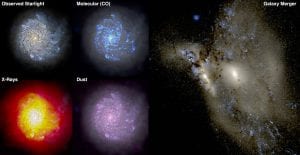Home
The FIRE project seeks to develop and explore cosmological simulations of galaxy formation that directly resolve the interstellar medium of individual galaxies while capturing their cosmological environment. FIRE aims to improve the predictive power of galaxy formation simulations by directly informing the implementation of sub-resolution processes with explicit small-scale models, thus reducing the reliance on adjustable model parameters.

Above: The large-scale gas distribution (left), face-on star light (middle), and edge-on star light (right) in a FIRE cosmological simulation of a Milky Way-mass galaxy.

Above: Mock images of another Milky Way-mass galaxy, in different wavelengths (left) such as observed starlight, radio images of molecular (CO) gas, X-ray images of hot coronal gas, and infrared images of dust. At right, we show a similar galaxy undergoing a violent collision and merger with an Andromeda-mass companion. In each, young star clusters are visible as bright blue regions, while dense gas and dust obscuration creates the red/brown lanes.
The FIRE simulations are used to address a wide array of questions in galaxy formation and intergalactic medium science, including the regulation of galaxy growth by “feedback,” the properties of galactic inflows and outflows, the morphological transformation of galaxies, the quenching of star formation in massive galaxies and the need for active galactic nucleus feedback, the escape fraction of ionizing photons from galaxies, and the effects of stellar feedback on dark matter halos.